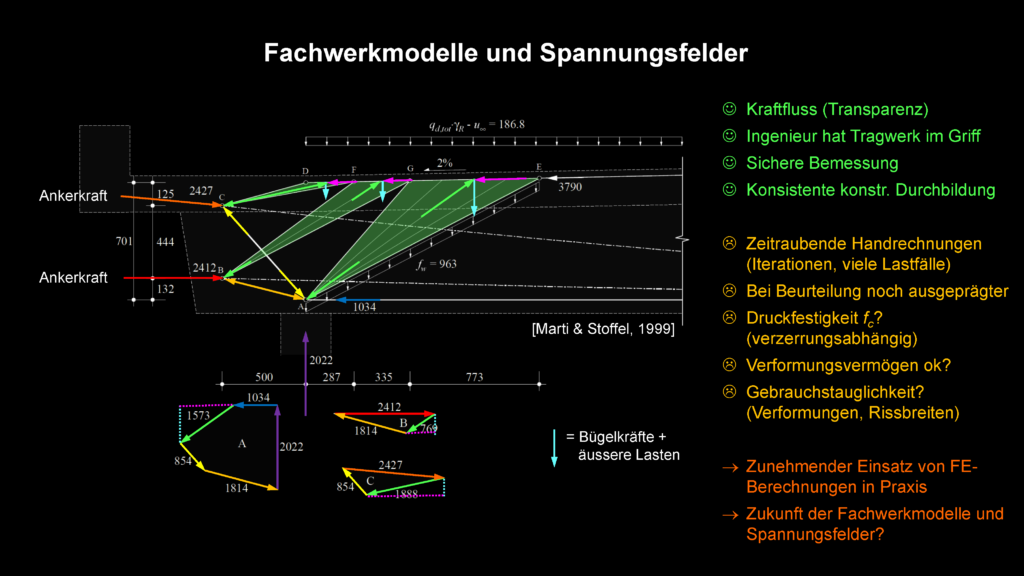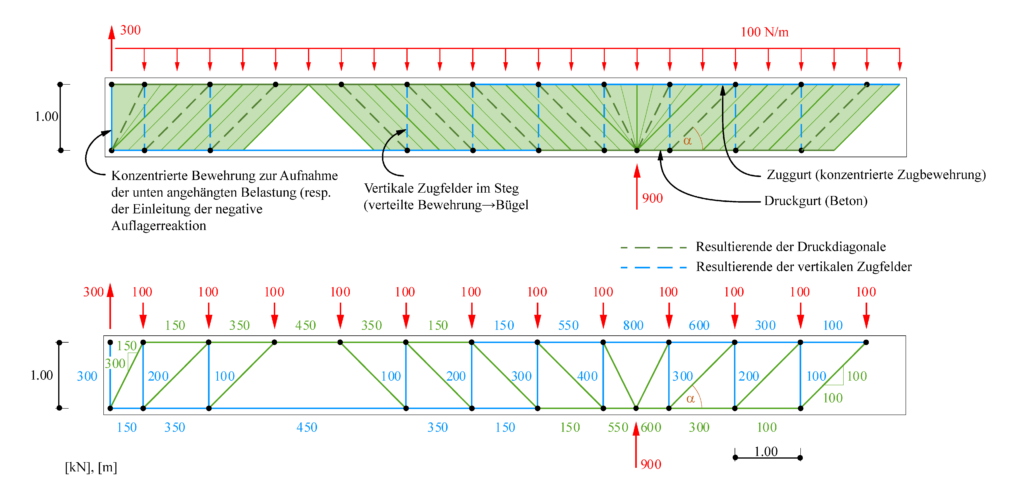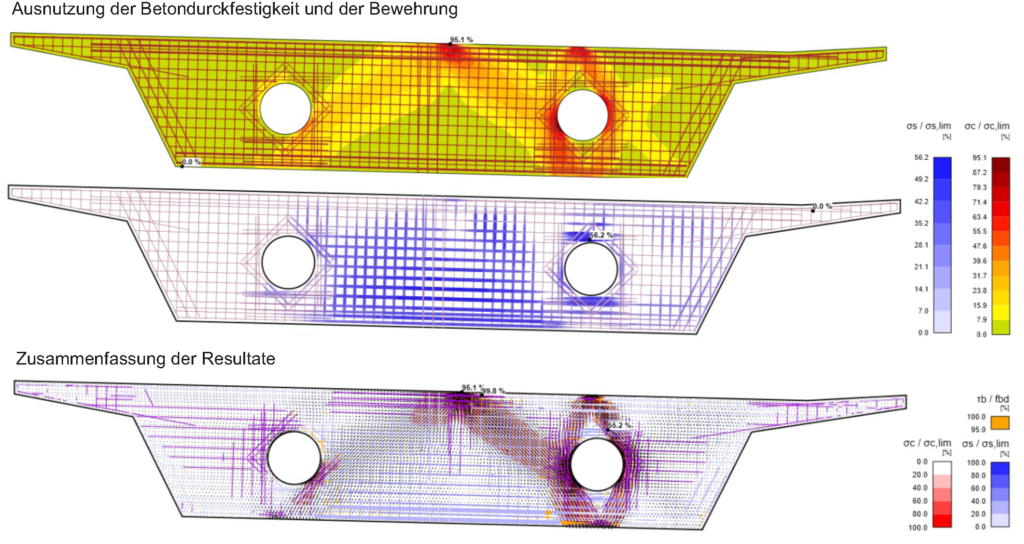Link zur deutschen Version: Sind Fachwerkmodelle im 21. Jahrhundert noch zeitgemäss?
For those of you who, like me, studied at ETH, the answer to the question posed by the title of this blog entry is obvious: generations of structural engineers acquired knowledge about truss models and stress fields for a good reason, and they still have a key role in my lectures as valuable tools for the design of concrete structures. But you still might be interested to learn why I am very concerned that truss models may no longer be used in the future – and what we have done to counteract the extinction of these methods?

The origins of truss models date back to the early days of reinforced concrete design. However, they were only put on a consistent mechanical basis and used for design decades later: In the second half of the 20th century, a handful of pioneers, including Professor Thürlimann and his assistants at ETH Zurich, dared to apply ultimate limit state design methods to reinforced concrete. To do so, they interpreted truss models as discontinuous stress fields, and these in turn as solutions according to the lower limit theorem of plasticity theory. Truss models thus provide conservative results and make it possible to neglect restraint stresses – which makes them a perfect instrument for design in the ultimate limit state of structural safety.
As self-evident as this may appear, at least to the ETH alumni among us, it was by no means straightforward at the time. Rather, the new theory initially met fierce opposition even within ETH Zurich (see, for example, Basler 1983). In fact, the ductility of reinforcement, and particularly that of concrete, is obviously limited. However, by neglecting the tensile strength of the concrete, providing adequate minimum reinforcement and applying cautious values for the concrete compressive strength, ductile behaviour can be ensured, thus meeting the prerequisites for the application of plasticity theory. As is well known, it is advisable to comply with these design rules in other cases as well. Otherwise, the design becomes semi-empirical and thus orders of magnitude more complicated.
Back to truss models: As already mentioned, they provide a consistent basis for the safe design of concrete structures, and in many cases allow a direct design of the reinforcement for a given applied load. The force flow can be traced and calculations are transparent and easily verifiable. Above all, the engineer is in control of the design and can, for example, choose a practical reinforcement layout. These are all clear advantages in design practice.

However, truss models also suffer from disadvantages. Since their geometry usually has to be adjusted iteratively and different load configurations have to be investigated, their use as hand calculations is often time-consuming in practice. In addition, they are not directly suitable for determining deflections and crack widths in service conditions, for which other models must be employed, and the dependence of the concrete compressive strength on the transverse strains stipulated by modern standards further complicates the manual development of truss models.
Hence, there is a clear tendency in practice to use any of the user-friendly software packages available today for structural analysis and design based on the finite element (FE) method, which can be used for safety and serviceability limit states – which often results in impractical and uneconomical reinforcement, but can be automated and is thus very efficient.
Unfortunately, the latter does not apply to manually developed truss models and stress fields. If these weaknesses of truss models are not eliminated, there is a genuine risk that they will soon be used only in classrooms – and perhaps as a visual tool for form-finding and tracing the flow of forces in conceptual design. I was already aware of this when I was still in industry, and I also knew how to counteract this development, as my predecessor had already proposed the solution more than 30 years ago (see quote): truss models must be implemented in user-friendly computer programs without compromising their advantages – transparency and control over the design.
Recent advances in computer development indicate that there might be much better ways of using the unique capabilities of computers to assist reinforced concrete designers in the future. There is a considerable potential for applying interactive computer programs with graphical input and output that could replace the traditional drawing board and pocket calculator methods for developing truss models. Apart from ultimate strength considerations, such programs would allow us to investigate the deformations in the cracked state by taking appropriate truss member stiffnesses into account.
Peter Marti: “Truss Models in Detailing,” Concrete International, Vol. 7, No. 12, Dec. 1985, pp. 66-73
However, the times were far from ripe for the implementation of this visionary idea. The first programmes for rigid-perfectly plastic stress fields (e.g. Hajdin 1990) were not very user-friendly. Neither these, nor the programmes developed soon thereafter for plastic design on the basis of linear elastic FE analyses (e.g. Despot 1995) were capable of investigating serviceability nor deformation capacity.
Similarly, when the first programmes for automated design of reinforced concrete with truss models were developed at the beginning of the 21st century, they did not succeed in practice. These discontinuous models ultimately failed in determining the concrete compressive strength and member stiffnesses in an automated and reliable way.
However, the EPSF programme developed at EPFL later indicated that the use of continuous stress fields simplifies this considerably (see Fernández Ruiz und Muttoni 2007). Essentially, EPSF is a simplified FE calculation. The programme is available free of charge, but requires knowledge of Java script and is of limited use for investigations of serviceability criteria and deformation capacity, since it neglects tensile stiffening and presumes linear elastic-ideal plastic material behaviour.

But actually, the implementation of more realistic material laws is straightforward, and in particular the tension chord model developed by Viktor Sigrist and Manuel Alvarez (Marti et al. 1998) is perfectly suited for this. On the one hand, the stiffening effect of the concrete between the cracks is captured in a mechanically consistent way, and on the other hand, the ultimate load is independent of the tensile strength of the concrete, thereby ensuring the link to limit analysis design methods.
When the Czech software company IDEA StatiCa contacted me shortly after my return to ETH Zurich to jointly develop “a tool for automated truss models”, I thus suggested exactly this: To link continuous stress fields with the tension chord model. In the meantime, the Compatible Stress Field Method (CSFM) has emerged from that idea, and the IDEA StatiCa Detail software, which is based on it. IDEA StatiCa Detail is available worldwide, including Switzerland (https://www.ingware.ch/produkte/statik-und-dynamik/idea-statica-detail/idea-statica-detail.html).

Being a commercial software, IDEA StatiCa Detail (after expiry of the evaluation licence) is not available for free. In exchange, however, it is very user-friendly and powerful. The basic principles and the results of its validation on numerous examples are compiled in a Verification Book, and I recently presented the programme – with a more extensive historical review of the development of stress fields and some application examples – at a training session (click here for the Youtube video).
Neither I personally nor ETH Zurich have any financial interest in the distribution of IDEA StatiCa Detail. Our advantage is immaterial: we hope to contribute to the preservation of the endangered species of truss models and stress fields. Whether you share this concern or are simply looking for an efficient tool for the design of reinforced concrete structures with stress fields: We would be pleased if you would give the programme a try.
Walter Kaufmann